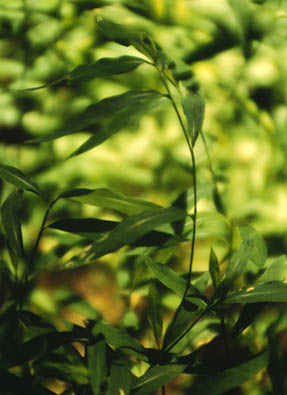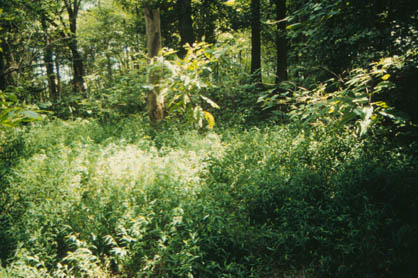

Taxonomic description of Microstegium vimineum (Trin.) A. Camus:
"Spikelets in pairs, alike, perfect, on an articulate rachis, 1 sessile, 1 pedicellate; racemes 1 to several, digitate or approximate; first glume sulcate. Straggling annuls with flat lanceolate blades" (Hitchcock, 747, 1971).
Authorities' full names: (Carl Bernhard von Trinius, 1778-1844) Aimee Antoinette Camus (1879-1975)
For the most part, Microstegium vimineum (Trin.) A. Camus,
does not have any listed common names, although at one time it
was known as Eulalia viminea and is sometimes referred
to as Eulalia. The species originally named as Microstegium
vimineum was described in Flore generale de L'Indo-Chine
by Aimee Antoinette Camus in 1922 (Jackson, 1893).
The book itself was not published until 1934 by M.H. le Comte.
It was locally unavailable; while the collection was presumably
made somewhere in the Indochina region, the specific location
is unknown, as is the location of the deposition of the original
species. For the complete text reference for Flore generale
de L'Indo-Chine see Camus, 1934.
Geography:
Worldwide, there are only 15 species of Microstegium. These
are primarily distributed throughout the tropical and subtropical
regions of Africa and Asia. Microstegium vimineum (Trin.)
A. Camus, is an introduced species in North America, found primarily
in the Eastern parts of the United States. In 1952, this species
was only considered adventive (non-naturalized) and only rarely
spotted in the United States (Gleason).
Now, it is commonly found throughout the East and spoke of as
naturalized (Watson & Dallwitz, 1992).
The following is a table detailing its presence or absence, ranging
from North America to habitats within Sam's Farm, a University
of Georgia 40 hectare plot in Clarke County, Georgia:
| ||
| North America:
Continental United States; Canada | ||
| Eastern North America:
United States east of Mississippi; Ontario and eastern Canada | ||
| Southeastern United States:
AL AR DE DC FL GA KY MD NC SC TN VA WV | ||
| Southern Appalachian States:
AL GA KY MD NC SC TN VA WV | ||
| Coastal Plain | Jones & Coile, 1988 | |
| Piedmont | Jones & Coile, 1988 | |
| Blue Ridge Mountains | ||
| ||
| Ridge and Valley | ||
| Cumberland Plateau | ||
| Central Arch | ||
| Georgia | ||
| Clarke County, Georgia | ||
| Sams Farm | ||
| ||
| ||
| ||
| ||
Natural History:
According to Fairbrothers and Gray, Microstegium vimineum (Trin.) A. Camus, was introduced into North America into the state of Tennessee from Asia in 1919 (1972). By 1960, it had a range at least as far west as Arkansas (Barden, 1987), as far south as Florida, and as far north as New Jersey, and is now spreading northeastward along river banks into New York and Connecticut (Hunt & Zaremba, 1992). This grass exists both as creeping annuals and persistent perennials, flourishing through the Summer and into the Fall but dying back quickly at frost temperatures. It flowers from September through October, although according to Reed Crook, Microstegium vimineum rarely flowers (pers. comm.), presumably because its success at spreading asexually and because of the persistences of its seed's viabilitiy (around 3 years) (Barden, 1987). This shade-loving plant is particularly successful in disturbed flood plains, especially along river banks (Barden, 1987;Hunt & Zaremba, 1992), but it is also found in undisturbed, low woods, marshes, wetlands, and ditches (Radford, Ahles, & Bell, 1968).

MICROSTEGIUM VIMINEUM GROWING ALONG A VERY DISTURBED STREAM BANK AT SAM'S FARM.
PHOTO BY: J.DAVID DANIEL (970802)
Considered problematic with regards to competition with more fragile, native species (Hunt & Zaremba, 1992), Microstegium vimineum (Trin.) A. Camus, was found to be only successful in invading habitats that have been disturbed in some way (Barden, 1987). This is primarily why it is found along riverbanks, where natural flooding occurs often. In some cases, it was found not to be successful in spreading from such riverbanks into adjacent forested areas (Barden, 1987). This has lead Hunt & Zaremba to speculate that Microstegium vimineum (Trin.) A. Camus may be limited in its colonization, at least to some degree, by soil type, preferring clay-soils (1992). This speculation is based primarily on its distribution in Georgia and the Carolinas, which corresponds closely to the extent of the Piedmont in these states (Jones & Coile, 1988; Radford et al., 1968).
Very little research exists with regards to Microstegium vimineum
(Trin.) A. Camus, yet it is a shade-tolerant C4 grass, which
is not altogether common. I have noticed on my farm in the Georgia
piedmont, where Microstegium vimineum is very common in
the forests, wetlands, and along riverbanks, that when given access
to a forested ravine, cattle consume the grass quite voraciously.
Yet the only research that even discusses this grass as anything
more than a small problem, is the listing of Microstegium vimineum
as an important weed species in Uphof's Dictionary of Economic
Plants (1968).